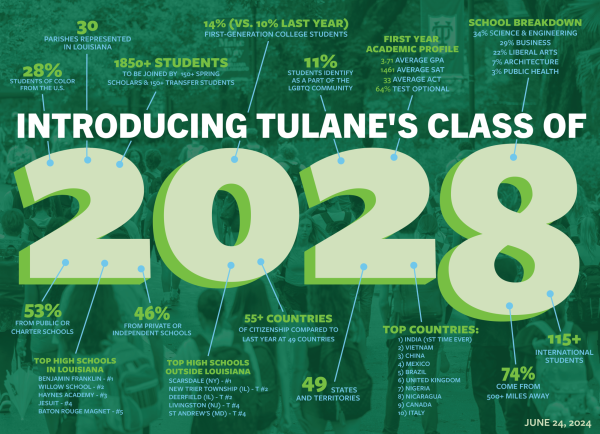
Tulane University welcomes the class of 2028 this fall, marking another record-setting year for Tulane admissions.
Tulane admitted around 4,500 students out of over 32,000 applicants. Some standout applicants include a member of the U.S. Women’s Ski Team, a national FIRST LEGO champion, a competitive barbecue Pitmaster, a ventriloquist and a national bodybuilding champion.
Tulane’s acceptance rate this year was around 13%, an increase from 8.5% since the class of 2026. This is largely due to Tulane’s continued effort to increase accessibility to underprivileged applicants.
Shawn Abbott, the vice president for enrollment management and the dean of admissions, previously stated that lower-income families are less likely to apply early decision because of the potential financial burden accompanying college acceptance. To accommodate lower-income applicants, Tulane continues to reduce the number of early decision acceptances to increase regular decision acceptances. During the 2023-2024 admissions cycle, Tulane stated that about 50% more students were accepted during the regular decision round compared to last year.
“We are intentionally attempting to move the needle in a positive direction to enroll more first-generation college students and more students from low-income backgrounds — particularly those who are likely to receive a federal Pell Grant,” said Abbott.
Further, the class of 2028 represents the most socioeconomically diverse class in Tulane’s history, including 14% first-generation students and 13% Federal Pell Grant recipients.
Despite the increase in socioeconomic diversity, ethnic diversity decreased this year. The incoming class saw increases and decreases in specific ethnic groups and a slight decrease in the overall percentage of students of color. 6% identify as African American or Black, 5% identify as Asian American, 12% identify as Hispanic, <2% identify as Native American and 5% identify as biracial or multiracial. Overall, around 28% of the class of 2028 identify as students of color.
The class of 2028 is one of the most geographically diverse classes to date, representing 49 states. The regions most represented include the Northeast at 26%, the Pacific West and the South Atlantic each at 14%. Louisiana comprises 14% of the incoming class, up from 11% the previous year. Moving forward, Tulane hopes to increase rural representation, particularly in Louisiana.
“We hope to expand our outreach and recruitment to students from rural areas of America, particularly along the Gulf Coast and especially here in Louisiana,” said Abbott. “We are looking closely at parish representation and the Office of Admission is working alongside our Louisiana Center for College Access to increase the number of parishes represented at Tulane.”
Additionally, the incoming class includes over 115 international students representing 55 countries of citizenship, a recent university record. This increase in international representation is partly due to Tulane’s extensive recruiting network abroad.
“We are increasingly spending more time on the ground recruiting abroad,” said Abbott. “We have a team of five admission officers with international recruitment responsibilities and we continue to expand our partnerships with organizations that could be viable pathways for more international students to find Tulane.”
While some admissions statistics have changed, others remain stagnant. Tulane’s gender disparity continues as 63% of the incoming class identifies as female. Overall, 61% of the Tulane student body identifies as female. Additionally, the class of 2028 includes 11% LGBTQ+ identifying students, down from 13% the previous year.



